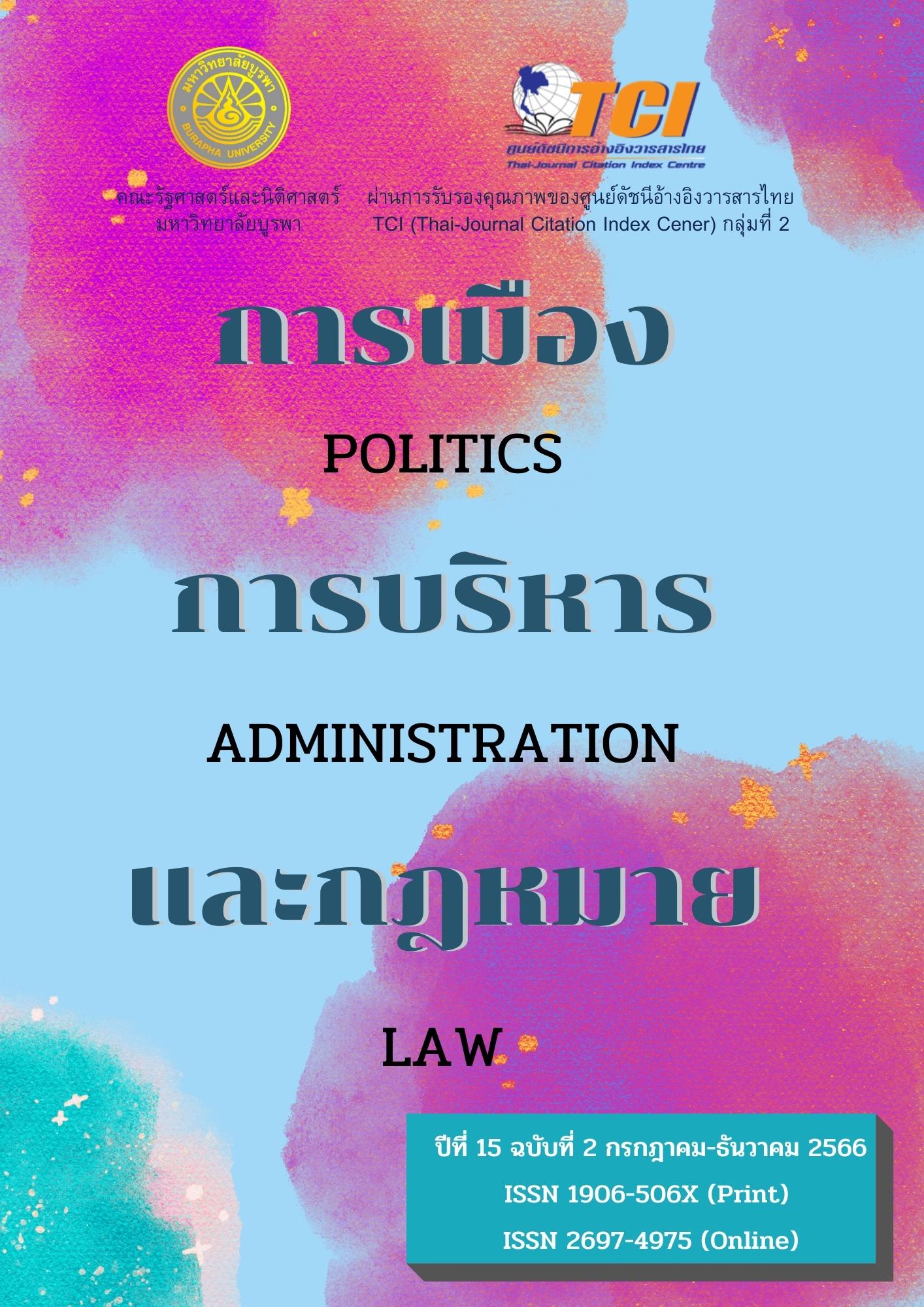Guidelines for Career Development by Value-chain Model of Hemp Fiber Product: A Case Study of Bang Phra Subdistrict Municipality in Chonburi Province
Keywords:
Supply chain, Value chain, Hemp, Hemp fiber productAbstract
The objectives of this research were 1) to study the characteristics of the supply chain and value chain of hemp fiber products. 2) to analyze information on occupations related to value chain of hemp fiber products. 3) to suggest guideline of jobs creating for Bang-Phra subdistrict municipality community. Mixed research method was used in this research. The quantitative research was studied from 389 sampling of residents in Bang-Phra subdistrict municipality which collected data by 5-scale Questionnaire. The qualitative research was studied from informant groups which were officer of Bang-Phra subdistrict municipality, community leaders and community agents, 3 sampling per groups by in-depth interviews. The data were analyzed with descriptive statistics and descriptive analysis. The research results were found that the topic received the highest point was community can develop an online sales career at 3.87 (agree). Next, the community could learn production methods (Knitting, weaving, sewing) at 3.84 (agree). The community could develop career of producer (Knitting, weaving, sewing) at 3.80 (agree). The important development guideline was to provide knowledge about production, selling in shop, selling online and income generating. And then, the government should support budget and value chain network should support inbound raw material. The research results could synthesize knowledge that value chain activities relate to job creation for communities was production, sales and value-added generating. So, policy planning, supporting and budget management to promote careers should build on these topics because communities accepted that it could lead to job development for the community.
References
กัลยา วานิชย์บัญชา. (2562). การวิเคราะห์สมการโครงการ(SEM) ด้วย AMOS (พิมพค์ร้ังที่ 3). กรุงเทพฯ: ห้างหุ้นส่วนจำกัดสามลดา.
กองควบคุมวัตถุเสพติด. (2562). คู่มือพนักงานเจ้าหน้าที่ในการกำกับดูแลซึ่งยาเสพติดให้โทษประเภท 5 เฉพาะเฮมพ์ (Hemp). กรุงเทพฯ: โรงพิมพ์สำนักงานพระพุทธศาสนาแห่งชาติ.
จุฬาภัทร์ อังศุพาณิชย์. (2565). อิทธิพลของการจัดการห่วงโซ่คุณค่าที่ส่งผลต่อความเจริญเติบโตของธุรกิจผ่านความสามารถทางการแข่งขันของธุรกิจอุตสาหกรรมอาหาร. วิทยานิพนธ์มหาบัณฑิต, มหาวิทยาลัยราชภัฎเพชรบุรี.
ฉัตรสุดา ธูปจันทร์. (2563). แนวทางการพัฒนาห่วงโซ่คุณค่าเพื่อสร้างความได้เปรียบทางการแข่งขันของศูนย์เมล็ดพันธุ์ข้าวนครสวรรค์. วิทยานิพนธ์ปริญญามหาบัณฑิต, มหาวิทยาลัยแม่โจ้.
ชุติระ ระบอบ. (2553). การจัดการโลจิสติกส์และโซ่อุปทาน. กรุงเทพฯ: มหาวิทยาลัยหัวเฉียวเฉลิมพระเกียรติ.
ชุติระ ระบอบ, ชีรวิทย์ สุรีรัตนันท์, บรรเจิดศักดิ์ สัณหภักดี, ชณิชา หมอยาดี, มรกต กำแพงเพชร และกัณต์ติกมาฐ รัตนปริญญานุกุล. (2562). การยกระดับโซ่คุณค่าของห่วงโซ่อุปทานปลาสลิดแปรรูป จังหวัดสมุทรปราการ. รายงานผลการวิจัย มหาวิทยาลัยหัวเฉียวเฉลิมพระเกียรติ.
ไชยยศ ไชยมั่นคง และมยุขพันธ์ ไชยมั่นคง. (2557). การจัดการซัพพลายเชนและช่องทางการตลาด. กรุงเทพฯ: วิชั่น พีเพรส.
ทรงธรรม เจริญจันทร์. (2563). การจัดการโลจิสติกส์และซัพพลายเชน. ชลบุรี: มหาวิทยาลัยราชมงคลตะวันออก.
เทศบาลตำบลบางพระ. (2566). รายงานสรุปผลการปฏิบัติงานทะเบียนราษฎรสำนักทะเบียนท้องถิ่นเทศบาลตำบลบางพระ ประจำเดือนมกราคม พ.ศ. 2566. วันที่ค้นข้อมูล 25 มีนาคม 2566, เข้าถึงได้จาก https://bangphrachon.go.th/
ธานินทร์ ศิลป์จารุ. (2555). การวิจัยและวิเคราะห์ข้อมูลทางสถิติด้วย SPSS (พิมพ์ครั้งที่ 11). กรุงเทพฯ: บิซิเนสอาร์แอนด์ดี.
นวลอนงค์ บุญฤทธิ์พงศ์. (2556). ระเบียบวิธีวิจัยทางการศึกษา. กรุงเทพฯ: จุดทอง.
สุทิน เรืองปานกัน, ทรงคุณ จันทจร และระพีพันธ์ ศิริสัมพันธ์. (2565). การศึกษาภูมิปัญญาในการผลิตเส้นใยกัญชงเชิงอุตสาหกรรมสิ่งทอชุมชน. วารสารวิจัยธรรมศึกษา, 5(2), 17-27.
สยุมพร บุญเกิด. (2565). มทร.ตะวันออก พร้อมขับเคลื่อนนโยบายลงสู่การปฏิบัติพัฒนากัญชา-กัญชง ในบริบทสถาบันอุดมศึกษา. วันที่ค้นข้อมูล 10 เมษายน 2566, เข้าถึงได้จาก https://www.radio.rmutt.ac.th/?p=25244
สุภาภรณ์ บุญเจริญ, อุษา สถิตย์มั่น, จิตสุภา สาคร และชัยวัฒน์ หฤทัยพันธ์. (2564). ปัจจัยที่ส่งผลต่อทัศนคติในการยอมรับการใช้ผลิตภัณฑ์จากัญชงในเขตพื้นที่บางพระ. รายงานผลการวิจัย มหาวิทยาลัยเทคโนโลยีราชมงคลตะวันออก
ศุภวิชญ์ ภูวประภาชาติ. (2563). การจัดการโซ่อุปทานของเกษตรกรผู้เลี้ยงแพะเนื้อในจังหวัดอ่างทอง. สารนิพนธ์ปริญญามหาบัณฑิต, มหาวิทยาลัยมหิดล.
อัจฉราวรรณ งามญาณ. (2554). อันเนื่องมาแต่สูตรของยามาเน่. วารสารบริหารธุรกิจ, 34(131), 46-60.
อรุณ จิรวัฒน์กุล. (2562). การใช้ตาราง Yamane อย่างไม่ถูกต้องคำนวณขนาดตัวอย่าง. วารสารวิชาการสาธารณสุข, 28(1), S3-S4.
Chou, Yen-Chun., & Shao, B. M., Benjamin. (2022). An Empirical Study of Information Technology Capabilities to Enable Value Chain Activities and Interfaces. Information Systems Frontiers (2023), 25, 1533–1547.
Pradabwong, J., Braziotis, C., Tannock, D. T., James., & Pawar, S., Kulwant. (2017). Business Process Management and Supply Chain Collaboration: Effects on Performance and Competitiveness. Supply Chain Management: An international Journal, 22(2), 107-121.
Sousa, Cristina., & Ferreiro, D.F., Maria. (2023). Small, Smart and Sustainable: Networking to Develop the Medicinal and Aromatic Plants Value-chain in Portugal. European Countryside, 15(3), 442 – 464.
Downloads
Published
Issue
Section
License

This work is licensed under a Creative Commons Attribution-NonCommercial-NoDerivatives 4.0 International License.






